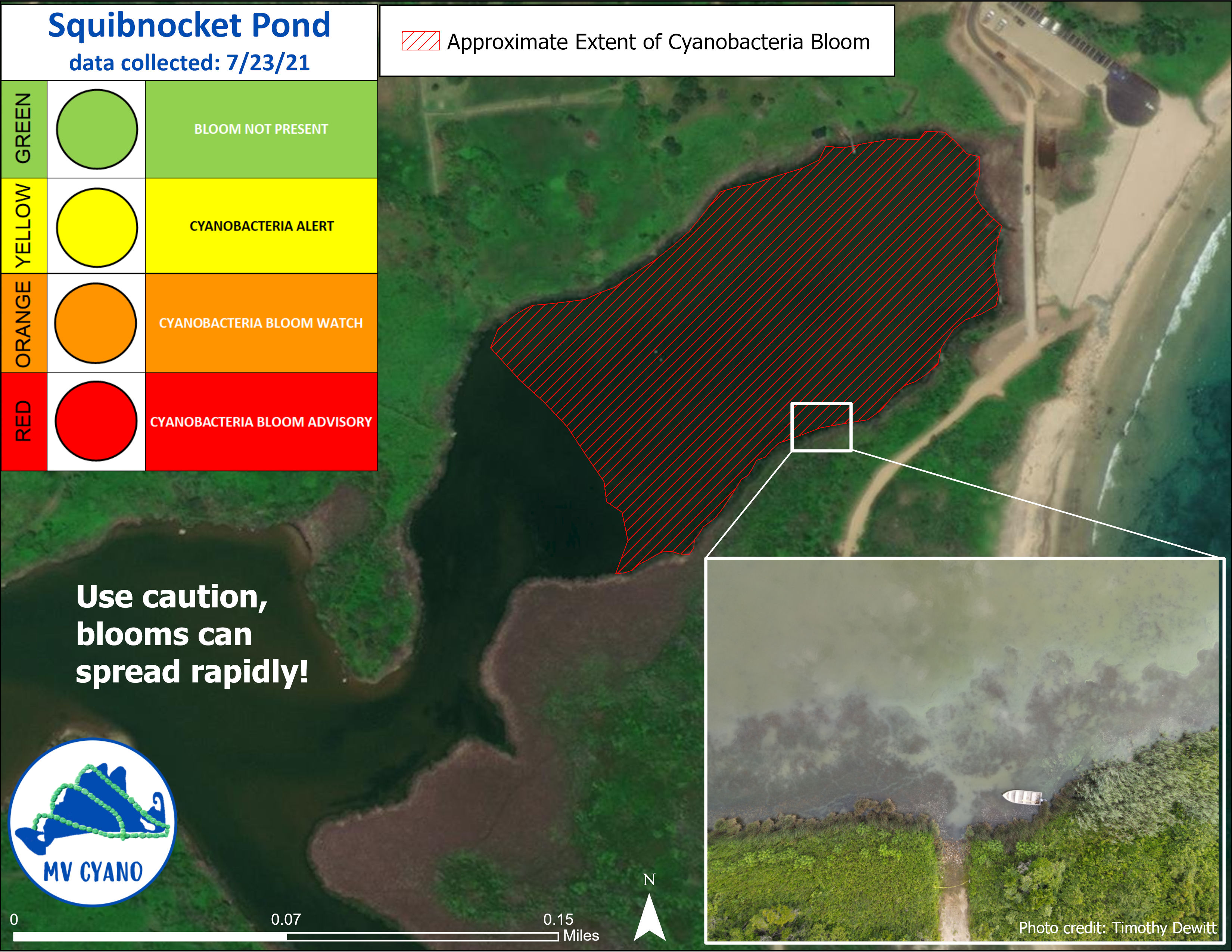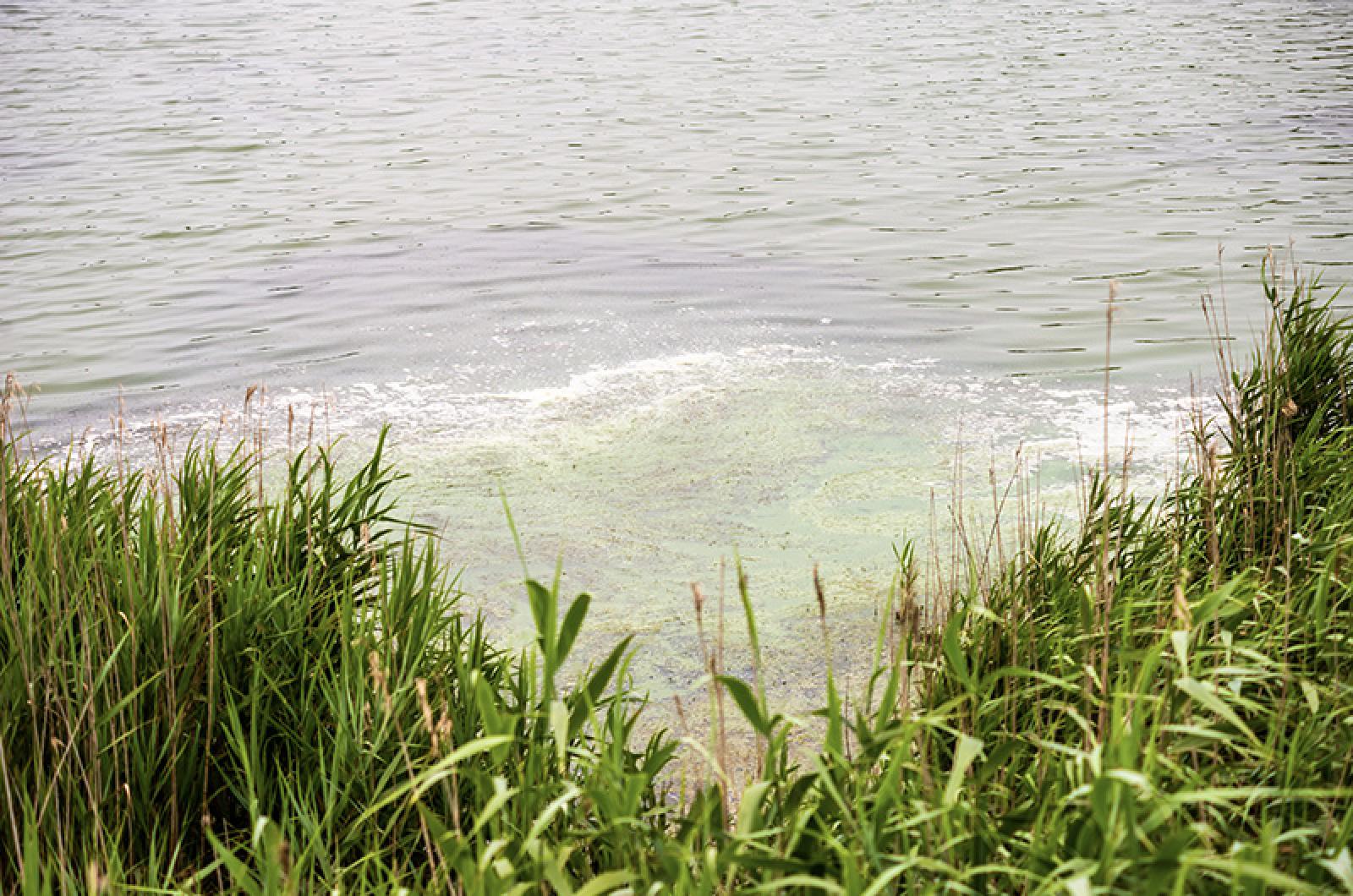Health agents and water quality experts have identified cyanobacteria blooms across Martha’s Vineyard, closing parts of Squibnocket Pond and issuing strong warnings about the toxic blue-green algae as summer heat sets in on the Island.
According to Chilmark health agent Marina Lent and Martha’s Vineyard Commission water resource manager Sheri Caseau, a large, shimmering algal bloom was discovered near the public landing at Squibnocket Pond last Thursday.
Health officials have closed the area of the pond affected by the algal bloom to recreational activity, including swimming, kayaking, fishing and shellfishing, and posted red signs advising Islanders to keep children and dogs away from the blooms.
“It was a very obvious cyano-bloom,” Ms. Lent said in an interview Monday. “You want a nice, even distribution of algae species. And when one dominates, it is easy to go into hyperdrive and start blooming. Squibnocket has indeed gone into hyperdrive and started blooming.”
Ms. Lent has also issued an orange warning for Chilmark Pond, with health officials and biologists identifying cyanobacteria levels far above the Environmental Protection Agency’s standard. Ponds are monitored on a yellow-orange-red system, with red advising against any recreational activity.
Ms. Caseau said at a meeting of the MVC Thursday night that blooms had also been identified at two private ponds near the Mink Meadows Golf Course in Vineyard Haven.
A microscopic organism that lives in both saltwater and freshwater, cyanobacteria are common to Island ponds but often bloom in late summer or early fall when temperatures stagnate and waters warm. The blooms can manifest in scummy, blue-green growths that release dangerous biotoxins often harmful to people, animals and the environment.
As temperatures rise, the frequency of blooms has increased across the Cape and Islands region, stretching earlier in summer and later through the fall. Dozens of ponds on Cape Cod have been closed this summer due to cyanobacteria blooms.
In 2020, a man was sickened while crabbing in Chilmark Pond after health agents identified a cyanobacteria bloom. Dog deaths connected to algal blooms have also been reported on the Island.
The bloom discoveries come after the commission and the University of New Hampshire partnered this summer to conduct an active water-quality monitoring program in 13 of the Island’s ponds and great ponds. The program is partially citizen-science based, with volunteers, health agents, land bank staff and biologists teaming up to test ponds biweekly — or weekly, if blooms are identified.
The Great Pond Foundation also launched MV CYANO, a collaborative with the Island boards of health and Chilmark Pond Foundation that, among other things, provides risk assessments for the ponds based upon cyanobacteria sampling.

At the commission meeting, Ms. Caseau urged Island residents to use the ponds cautiously, and said that the cyanobacteria species Dolichospermum, identified in Chilmark and Squibnocket Ponds, can be particularly hazardous to dogs. She also said that picocyanobacteria, which don’t form blooms but can emit toxins at high levels, were identified in James Pond earlier in the year.
“I don’t want people to panic, but you really should use caution,” Ms. Caseau said of Squibnocket Pond. “So, you can still do water sports, but I would just be careful that no one ingests it. I wouldn’t drink that water, anytime, ever.”
Although the monitoring program in upper Chilmark Pond has not yet shown any blooms during the summer of 2020, Ms. Caseau said the quantity of bloom-forming organisms is growing. The orange caution advises recreational pond-goers to rinse off after getting in the water and to not consume shellfish from the pond.
“A couple of weeks ago we had one or two organisms. Then last week we had nine. Today we have 19,” Ms. Caseau said of Chilmark Pond. “So we are expecting a bloom, an active, large bloom.”
According to Ms. Lent, the bacteria levels identified in Chilmark Pond are much higher than federal and state drinking water standards, although both she and Ms. Caseau noted that the EPA and state DPH have a limited understanding of cyanobacteria blooms in brackish coastal ponds.
They are hoping that further study with UNH, as well as the active monitoring program, will help give the Island a baseline for its bacteria levels.
“Both the commission and the Great Pond Foundation have really upped our game this year,” Ms. Lent said. “The DPH standard is very primitive at this point. They’re like, if you see blue-green scum, stay out of the water. We sort of feel that we wanted to do a little more.”
Ms. Caseau and commission cartographer Chris Seidel are in the process of putting together an online pond-quality resource that updates with information from the monitoring program, using StoryMap technology.
The blooms identified in Island ponds this summer are similar to blooms found in 2020, Ms. Caseau said, with blue-green scum found in almost the exact same location in Squibnocket Pond, although health agents have not heard reports of any sick animals or humans in 2021.
Ms. Lent added that she expected the bloom to remain — at least in the short-term, with summer temperatures continuing to rise.
“These things change if the weather is different,” Ms. Lent said. “But the pond remains stagnant, warm and shallow.”






Comments (8)
Comments
Comment policy »